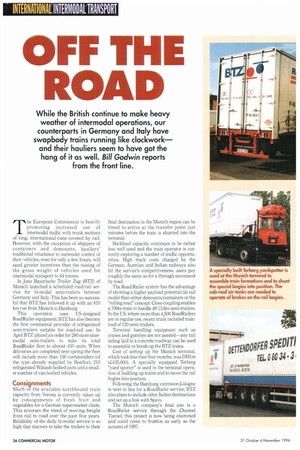OFF TH ROAD
Page 38

If you've noticed an error in this article please click here to report it so we can fix it.
The European Commission is heavily promoting increased use of intermodal traffic with trunk sections of long, international runs covered by rail. However, with the exception of shippers of containers and demounts, hauliers' traditional reluctance to surrender control of their vehicles, even for only a few hours, will need greater incentives than the raising of the gross weight of vehicles used for intermodal transport to 44 tonnes.
In June Bayerische Trailer Zug (BTZ) of Munich launched a scheduled road/rail service for bi-modal semi-trailers between Germany and Italy. This has been so successful that BTZ has followed it up with an 810 km run from Munich to Hamburg This operation uses US-designed RoadRailer equipment; 131Z has also become the first continental provider of refrigerated semi-trailers suitable for road-rail use. In April BTZ placed an order for 280 more intermodal semi-trailers to take its total RoadRailer fleet to almost 450 units. When deliveries are completed next spring the fleet will include more than 150 curtainsiders (of the type already supplied by Boalloy), 210 refrigerated Wabash-bodied units and a smaller number of van-bodied vehicles.
Much of the available northbound train capacity from Verona is currently taken up by consignments of fresh fruit and vegetables for a German supermarket chain. This reverses the trend of moving freight from rail to road over the past five years. Reliability of the daily bi-modal service is so high that tractors to take the trailers to their final destination in the Munich region can be timed to arrive at the transfer point just minutes before the train is shunted into the terminal.
Backload capacity continues to be rather less well used and the train operator is currently exploring a number of traffic opportunities. High track costs charged by the German, Austrian and Italian railways also hit the service's competitiveness: users pay roughly the same as for a through movement by road.
The Road/Railer system has the advantage of showing a higher payload potential (in rail mode) than either demounts/containers or the "rolling road" concept. Close-coupling enables a 700m train to handle 49 13.6m semi-trailers. In the US, where more than 4,500 RoadRailers are in regular use, recent trials included trainload of 120 semi-trailers.
Terminal handling equipment such as cranes and gantries are not needed—any rail siding laid in a concrete roadway can be used to assemble or break-up the BTZ trains.
Cost of setting up the Munich terminal, which took less than four months, was DM1m (£435,000). A specially equipped Terberg "yard spotter" is used in the terminal operation of building up trains and to move the rail bogies into position.
Following the Hamburg extension Cologne is next in line for a RoadRailer service; BTZ also plans to include other Italian destinations and set up a link with Spain.
The Munich company's final aim is a RoadRailer service through the Channel Tunnel; this project is now being examined and could come to fruition as early as the autumn of 1997.




































































































































